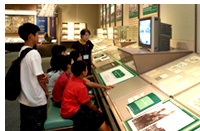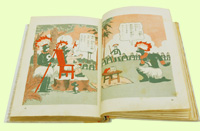| |


|
|
 |
 |
 |
Although the Manchurian Incident in 1931 launched the Fifteen-Year War and Japan's major push for territorial expansion, even before this drive began, Japan had colonized Korea, Taiwan and southern Sakhalin, taken control of the Chinese state of Guangdong through a leasehold agreement, and begun governing numerous islands in the South Pacific under League of Nations mandates. When the War broke out, many people from these occupied countries and territories were mobilized to work in the munitions industry, sometimes even being brought to Japan against
their will to work for Japanese companies. Many were drafted as soldiers, while others were mobilized as civilian support for Japanese troops.
 Local governments in occupied China and Southeast Asian were
replaced with puppet regimes through which the Japanese army could exert control
and force cooperation with Japan in the War. People in the occupied territories
were also forced to assimilate to Japanese culture and show respect for the Japanese
Emperor. Local governments in occupied China and Southeast Asian were
replaced with puppet regimes through which the Japanese army could exert control
and force cooperation with Japan in the War. People in the occupied territories
were also forced to assimilate to Japanese culture and show respect for the Japanese
Emperor.
|
 |
Many of the people in the Asian territories occupied by Japan actively resisted Japan's aggression and occupational rule. Japan, in turn, made excuses for its actions and tried to find people who would cooperate with
the occupying forces, but it failed to win the hearts and minds of the local populations. When people refused to cooperate, Japanese troops used brute force to suppress resistance, destroying cities and villages where they encountered trouble. Even so, resistance did not die out. The anti-Japanese activities of the Asians under Japanese control were eventually tied into international movements against war and Fascism, and ultimately, formed the basis of national independence movements.
|
| |

|
There are pass issued by the Kuomintang (Chinese
Nationalist Party), and a "surrender certificate" issued by the Japanese army.
Both say that holders could pass checkpoints freely and that their safely would
be guaranteed. (Donated by Chikako Seguchi)
|
|
|
| |
 Comic "The
Adventures of Dankichi" Comic "The
Adventures of Dankichi" |
|
 “The Adventures of Dankichi”, by Keizo Shimada,
seen right, tells the tale of Dankichi, a Japanese who became king of a South
Pacific island. Along with "Norakuro" by Suiho Tagawa, this was one of the most
popular children's comics during the War because it imparted a dream of easy
wealth. “The Adventures of Dankichi”, by Keizo Shimada,
seen right, tells the tale of Dankichi, a Japanese who became king of a South
Pacific island. Along with "Norakuro" by Suiho Tagawa, this was one of the most
popular children's comics during the War because it imparted a dream of easy
wealth.
|
|
|
| |
|
|
|
 |
|
|
|